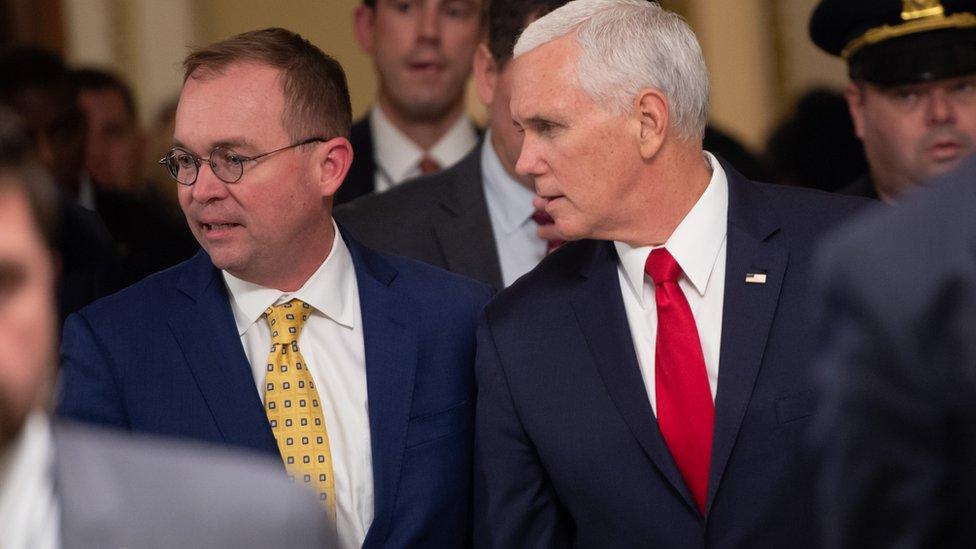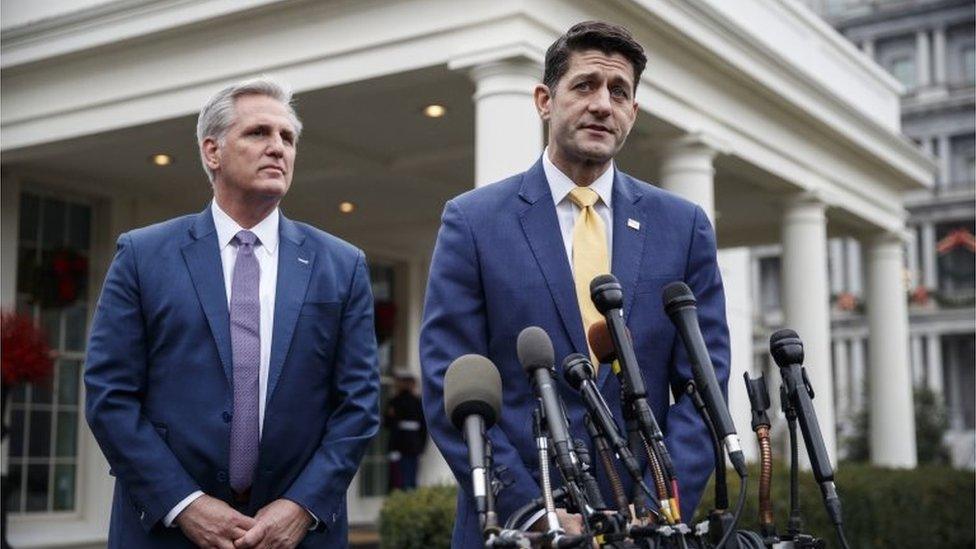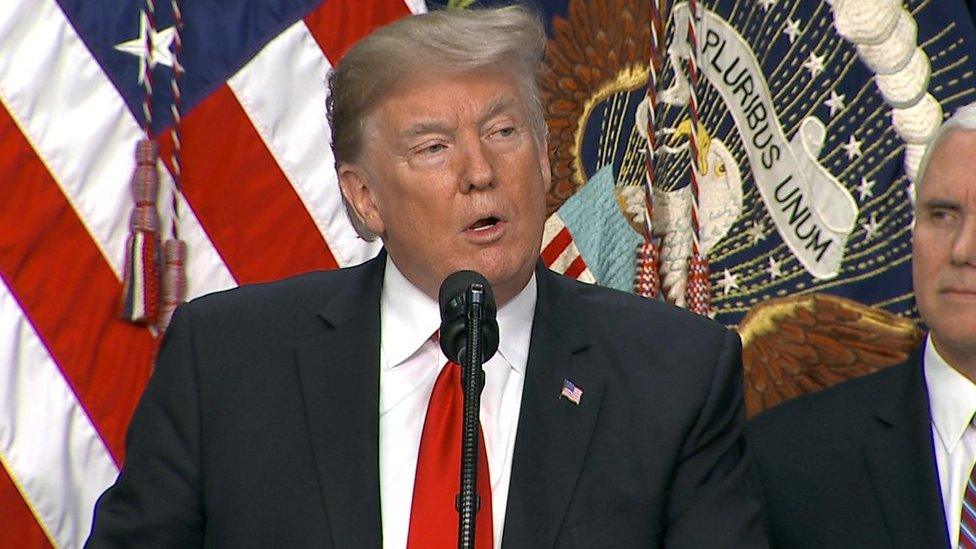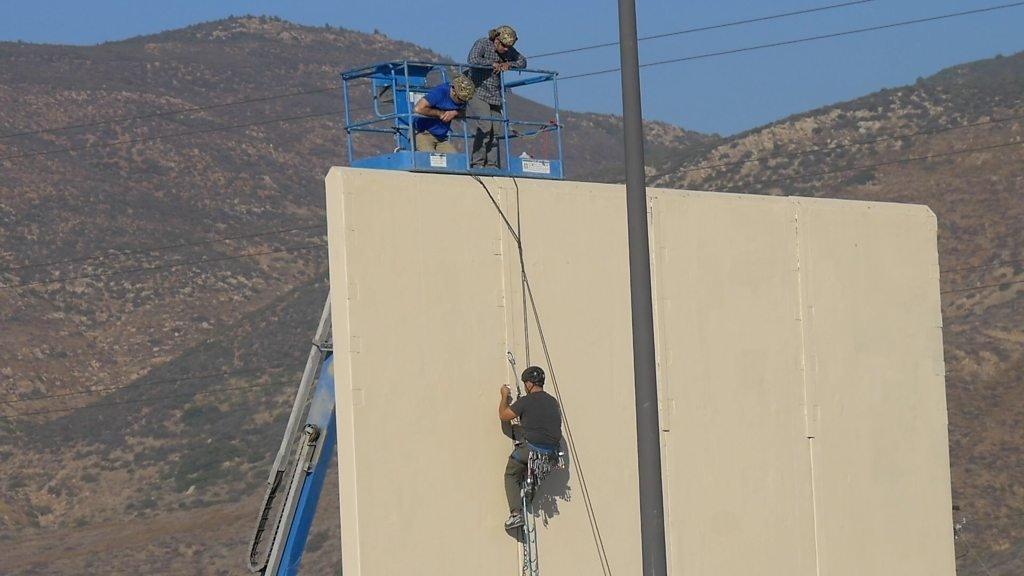US government partially shuts down over border wall row
- Published
Trump: "Any measure that funds the government must include border security"
A partial US government shutdown has taken effect after US lawmakers failed to break a budget impasse.
President Donald Trump, who has to sign off on any deal, is insisting at least $5bn (£4bn) be included for his long-promised wall along the Mexican border.
In the absence of a deal, funding for about a quarter of US federal agencies lapsed at midnight (05:00GMT Saturday).
Congress began rare Saturday sessions at about noon local time to try to resolve the issue.
Meanwhile, nine of 15 federal departments, including State, Homeland Security, Transportation, Agriculture and Justice are now partially shutting down.
Hundreds of thousands of federal employees will have to work unpaid or are furloughed, a kind of temporary leave. This is the third time US federal funding has lapsed so far this year, although the other two were brief.
What is the row about and how did we get here?
It's pretty much all about the wall.
On Wednesday, a bilateral deal appeared to have been agreed in the Senate to keep federal agencies open until 8 February. But the agreement did not include funding for Mr Trump's wall.
Mr Trump then dug his heels in over the issue after criticism from conservative talk show hosts and other allies, and insisted that funds for the wall must be included for him to sign the budget off.
The Republican-controlled House then passed a bill on Thursday approving $5.7bn (£4.5bn) of funding for the wall.
Mr Trump is well aware the Democrats are taking control of the House in January and wall funding will then be opposed.

The US Capitol was abuzz with last-ditch negotiations on Friday
But the other problem for Mr Trump is that he does not have the 60 votes in the 100-seat Senate he needs to get the House budget passed.
No amount of shuttling between party negotiators on Capitol Hill could resolve the issue before the Saturday deadline.
So what happens now?
Senate majority leader Mitch McConnell addressed a new session on Saturday saying the "pause button" had been pushed and that there would be no new Senate vote until he had a signature from the president - and agreement from the Democrats - on a budget deal.
In a tweet on Saturday, Mr Trump said he was "working hard" but that negotiations with the Democrats could be "a long stay".
The Democrats remain staunchly opposed to funding for the wall, with Senate Democratic leader Chuck Schumer saying President Trump had "thrown a temper tantrum and now has us careening towards a 'Trump shutdown' over Christmas".
But some lawmakers were hopeful that there could be a deal involving less money for the wall and more restrictions on it.
Nevertheless, Mr Trump has also suggested Mr McConnell should invoke the so-called "nuclear option" to break the impasse.
The option would mean the bill could be approved in the Senate with a simple majority instead of the 60 currently required.
Allow X content?
This article contains content provided by X. We ask for your permission before anything is loaded, as they may be using cookies and other technologies. You may want to read X’s cookie policy, external and privacy policy, external before accepting. To view this content choose ‘accept and continue’.
But Mr McConnell has repeatedly refused in the past to invoke such an extreme legislative manoeuvre. A number of Republican senators on Friday also made clear their staunch opposition to the proposal.
What will the shutdown mean?
About 380,000 government employees will be made to take temporary, unpaid leave.
Meanwhile, 420,000 employees working in essential roles - considered necessary for the "protection of life and property" - will keep working, without being paid.
In practice, this means that:
Customs and border staff will keep working, although their pay will be delayed. Airports will continue operating.
About 80% of National Parks employees will be sent home, and parks could close - although some may stay open with limited staff and facilities.
About 90% of housing department workers will take unpaid leave, which could delay loan processing and approvals.
Most of the Internal Revenue Service (IRS) will be sent on unpaid leave, including those who assist taxpayers with queries.
The Food and Drug administration will pause routine inspections but "continue vital activities".
The remaining 75% of the federal government is fully funded until September 2019 - so the defence, veterans affairs, labour and education departments are not affected.

'It's tremendously stressful'
Martin Ely, 54, a tax officer in Arizona, is affected by the shutdown and says he's frustrated with the politicians.
"I would like them not to use us a bargaining chip.
"I was last paid a week ago and hopefully should still be paid on 30 December for this week just gone, but anything after that will definitely be affected by the shutdown.
"I have been an IRS employee for around nine years, and I was furloughed during the 2013 shutdown that lasted from October 1st-17th. Being furloughed is never a pleasant experience. Having to live on savings and/or credit while waiting for back pay, which must be approved by Congress, is tremendously stressful.
"During the 2013 shutdown, I spent the entire time glued to the TV watching the news and waiting to be called back to work. Many of my co-workers did the same. We can't travel far or plan a vacation during a shutdown because we usually only get a day's notice or less to report back to work. So it's no holiday, especially during the Holidays."

Why does Mr Trump want the wall?
A strengthened southern border wall was a key election promise for Mr Trump.
On Friday Mr Trump shared a graphic of his steel-slat wall design for the wall.
Allow X content?
This article contains content provided by X. We ask for your permission before anything is loaded, as they may be using cookies and other technologies. You may want to read X’s cookie policy, external and privacy policy, external before accepting. To view this content choose ‘accept and continue’.

Later, he posted a video regarding the immigration row, where he said it was "very dangerous out there".
His address, which was spliced with footage that appeared to show immigrants pushing down border fencing, cautioned about drugs and violent gang members entering the country illegally.
During his campaign he insisted he would make Mexico pay for it, but the country has refused.
This week Mr Trump's supporters created a crowdfunding page for the building process - an appeal that has so far raised more than $13m (£10m) in just four days.
- Published21 December 2018

- Published20 December 2018

- Published8 December 2017
